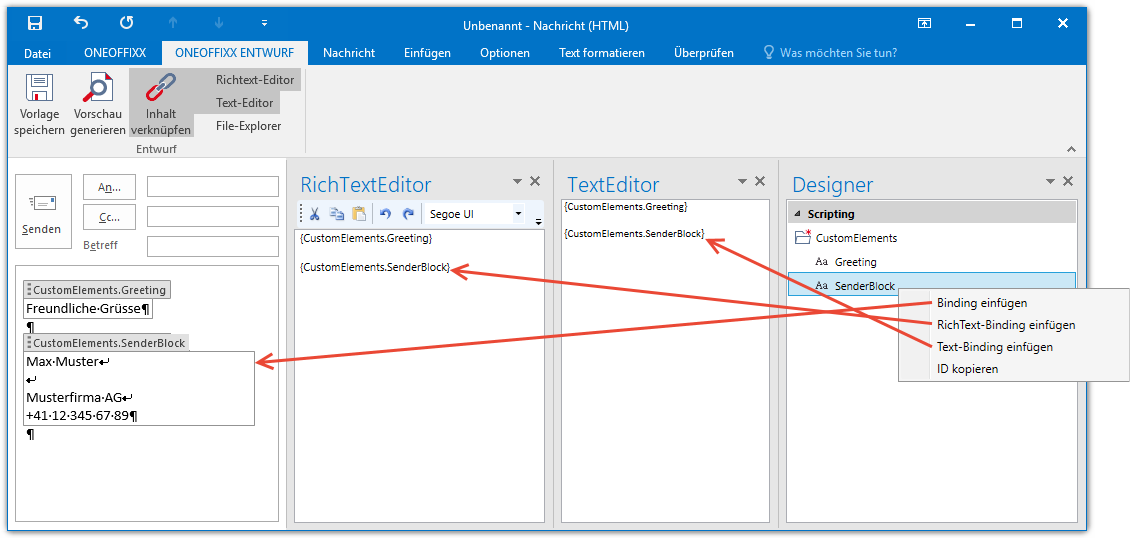Access to OneOffixx fields
There are numerous fields available in OneOffixx. OneOffixx fields are text containers that have an Id. The content of these fields is determined by the document functions and/or by a Connect call during generation. Some typical examples of OneOffixx fields:
| Id | Possible content | Document function |
|---|---|---|
DocParam.Subject |
May contain the subject entered by the user in the document parameter dialog | DocumentParameter |
Profile.User.Email |
May contain the e-mail address of the person who generates the document | ProfileData |
Contact.Recipient.Selected.Person.FirstName |
May contain the first name of the recipient selected in the recipient dialog | RecipientAddresses |
CustomElements.SenderAddressBlock |
May contain the sender's address block created according to certain script rules | Skripte |
MyExampleApplication.ProjectNo |
May contain the project number from the Connect call of a specialist application | CustomInterfaceConnector |
These fields can be accessed from the document functions Scripts and Library for advanced binding (Extended bindings). They are stored in the generated document in the CustomXMLPart named OneOffixxDocumentPart.
Finally, it must be possible to reproduce the contents of the fields in the templates. Below is listed how this content is transferred to the documents in different scenarios.
Word
In Word, OneOffixx fields are inserted with "Plain Text Content Controls". The OneOffixx Word add-in must be used as follows:

Word fields
Word itself also offers fields, for example, the page number, the document name or the print date. These already existed before Word 2007 and can be inserted with Ctrl+F9 or via Insert → Quick Parts → Field.... There are scenarios where it is desired that these fields are updated.
In the following situations, the Word fields are automatically updated:
- When clicking on one of these buttons in the OneOffixx ribbon in the "Completion" group: Print, Send, Preview, Save PDF
The update also takes place when "Cancel" is selected on any subsequent dialog. - When opening the document, if the user-defined document property "OORefreshFieldsOnOpen" is of type Boolean (Yes or No) and true (Yes).
- When Saving the document, if the user-defined document property OORefreshFieldsOnSave is of type Boolean (Yes or No) and true (Yes).
The mentioned custom document properties can be set via the document function Metadata.
Outlook
Content:
- HTML: with "Plain text content controls", analogously to Word.
- RichText: with RichText bindings;
{IdDesOneOffixxElements} - Text: with text bindings;
{IdDesOneOffixxElements}
These three types can be inserted via the OneOffixx Outlook add-in as follows:

To, Cc, Bcc and subject field:
In e-mail templates the To, Cc, Bcc and subject fields are inserted with bindings: {IdDesOneOffixxElements}. Here OneOffixx fields can also be composed of other text.
Examples:
{DocParam.Subject}becomesAnfrageNr.: {DocParam.ProjectNo}becomesNr.: 110475{CustomElements.SmsPhoneNumber}@smsservice.mycompany.combecomes41123456789@smsservice.mycompany.com
